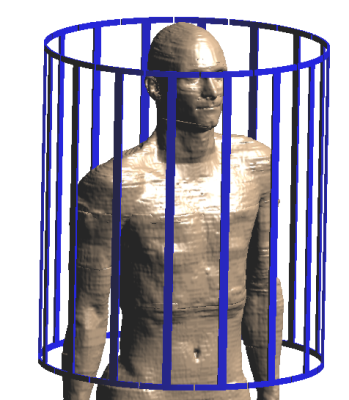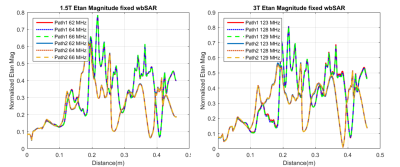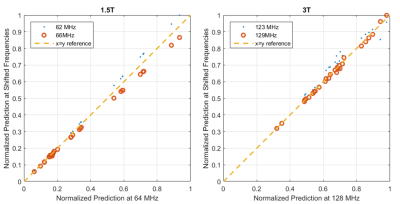4824
Impact of RF Frequency Variation on AIMD MRI RF Safety Assessment1Abbott Laboratories, Sylmar, CA, United States
Synopsis
To assess the impact of RF frequency variation on AIMD MRI RF safety, the tangential electric field and cardiac pacing lead electrode RF heating transfer functions were obtained at different frequencies: around 64 MHz for 1.5T scanners and 128 MHz for 3T scanners. The result shows that the impact on in vivo RF heating prediction due to RF frequency shift is insignificant.
Introduction
Magnetic Resonance Imaging (MRI) requires strong static magnetic field. Most of the commercial MRI scanners today have static field strengths around 1.5T or 3T. Due to different design and manufacturing processes, the static magnet strength of a commercial scanner can vary, which leads to different RF frequencies. Additionally, the Simultaneous Multi-Slice (SMS) imaging technique has been gaining popularity in recent years to speed up the MRI scanner image acquisition. As a result, the RF frequency bands are broadened. When patients with Active Implant Medical Devices (AIMDs) are exposed to different RF frequencies, the impact of RF frequency range covered by clinical MR scanners should be assessed for AIMD MRI RF safety analysis.Methods
A survey of RF frequency was conducted on several commercially available MRI systems. To assess the impact of RF frequencies on AIMD MRI RF safety, the following frequencies were selected for investigation: 1) 62 MHz, 64 MHz (considered as the baseline frequency for 1.5T scanners), and 66 MHz for 1.5T scanners and 2) 123 MHz, 128 MHz (considered as the baseline frequency for 3T scanners), and 129 MHz for 3T scanners.An adult male body model (Duke from IT’IS Virtual Population1) in a RF coil was numerically modeled at each frequency. Circular polarization (CP) was applied for the RF coil. The body model was placed inside each coil at the thoracic position (See Figure 1). The electric conductivity and permittivity of each human tissue, at respective frequency, was assigned based on the IT’IS tissue database2. The tangential electric field (Etan) along clinically relevant cardiac lead trajectories were extracted.
Meanwhile, the RF heating transfer function3 (TF) of a commercially available cardiac lead (with 46 cm length) was measured at the selected frequencies, with a resolution of 1 cm step size. The TF magnitudes were normalized to the same root-mean-square(rms) value.
Results
The Etans along the cardiac leaded trajectories were scaled to fixed whole-body SAR (wbSAR) as defined in ISO/TS 109744. As shown in Figure 2, the Etan magnitude was plotted for two typical cardiac lead trajectories (Path1 and Path2, representing the left and right side of the human body) at different frequencies. Negligible differences were observed among different frequencies. To quantify the differences, an impact term µEtan is defined by averaging the point-to-point percentage difference from the center frequency (64MHz for 1.5T and 128MHz for 3T) along the cardiac lead length. For the selected frequencies, the tangential E field magnitude percentage differences from 64 MHz and 128 MHz were calculated for each of the clinically relevant cardiac leaded pathways. For 1.5T scanners, the maximum µEtan is found to be 0.84%. For 3T scanners, it is found to be 2.17%. Finally, to assess the overall effect of RF frequency variation on AIMD MRI RF safety, a realistic in vivo RF heating scenario is investigated. The tangential E fields at a given RF frequency (among the 6 selected frequency points) were combined with the associated RF heating TF of that frequency to create the predicted in vivo temperature rise. Scatter plots were made to compare the difference among the 1.5T and 3T frequencies (Figure 3). The largest percentage differences averaged between 0.8 and 1 on the x axis in Figure 3 were 7.53% for the 1.5T frequencies and 3.94% for the 3T frequencies.Discussion
The impact from tangential E-field due to RF frequency shift (i.e., 62 to 66 MHz for 1.5T, 123 to 129 MHz for 3T) was found to be less than 2%. The impact on in vivo RF heating prediction is less than 8%. This amount of influence is small when compared to combined standard uncertainty 1.36dB (i.e. 37% percentage difference) published in literature5. This confirms that the impact on 1.5T and 3T RF heating from scanner RF frequency variation can be considered insignificant.Conclusion
For an AIMD MRI 1.5T and 3T RF heating safety analysis, the impact of RF frequency variation on in vivo RF heating prediction is found to be 7.53%, this is not expected to affect the overall MRI RF heating implant safety assessment.Acknowledgements
No acknowledgement found.References
1. A. Christ, et al, “The Virtual Family - Development of Anatomical CAD Models of two Adults and two Children for Dosimetric Simulations”, Physics in Medicine and Biology, 55, N23–N38, 2010
2. IT’IS Tissue Database, https://itis.swiss/virtual-population/tissue-properties/database/
3. S. Feng, R. Qiang, W. Kainz, and J. Chen, “A technique to evaluate MRI induced electric fields at the ends of practical implanted lead,” IEEE Trans. Microwave. Theory Techn., vol. 63, no. 1, pp. 305–313, Jan. 2015
4. ISO/TS 10974:2018, Assessment of the safety of magnetic resonance imaging for patients with an active implantable medical device
5. J. Córcoles, A. Yao, and N. Kuster, Applied Mathematical Modelling, August 2021, Volume 96, pages 177-188, online 09 March 2021; doi: 10.1016/j.apm.2021.02.036
Figures


